One integral aspect of the Proof-of-Work blockchain ecosystem is the so-called crypto mining mechanism, which plays a crucial role in securing the network, validating transactions, and creating new coins.
Let’s explore what crypto mining is, how it works, and its significance in the world of cryptocurrencies.
What is Crypto Mining?
Crypto mining refers to the process of validating and recording transactions on a blockchain network while also adding new coins to the system. It’s a fundamental mechanism that ensures the integrity and security of cryptocurrencies like Bitcoin, among others.
How Does Crypto Mining Work?
Crypto mining involves complex mathematical calculations that are computationally intensive, i.e., powerful computers that provide a lot of processing power are required to “mine” cryptocurrency.
Miners, who are the individuals or entities participating in the process, use powerful computer hardware to solve mathematical puzzles.
Their goal is to find a specific value, called a “hash,” that satisfies certain criteria – a mechanism known as “proof-of-work” (PoW) in some cryptocurrencies.
Here’s a step-by-step breakdown of the crypto mining process:
Transaction Verification
When a user initiates a cryptocurrency transaction, it is broadcast to the network. Before adding this transaction to the blockchain, miners verify its validity.
They check if the sender has enough funds to make the transaction and that the transaction adheres to the rules of the cryptocurrency’s protocol.
Read more: How blockchains work
Creating a Block
Valid transactions are grouped together into a “block.” A block serves as a container for multiple transactions and is typically limited in size. Each block also contains a reference to the previous block, forming a chain of blocks, hence the name “blockchain.”
Solving the Hash Puzzle
Once a block is created, miners compete to solve a cryptographic puzzle unique to that block. The puzzle involves finding a specific hash value that meets certain criteria. This process requires miners to perform numerous random calculations until they find a hash that satisfies the criteria.
Proof of Work
The first miner to solve the hash puzzle broadcasts the solution to the rest of the network for verification. Other miners can quickly validate this solution, ensuring that it is correct.
If the solution is verified, the new block is added to the blockchain, and the miner who found the solution is rewarded with newly minted coins and transaction fees from the included transactions.
Difficulty Adjustment
To maintain a consistent rate of block creation, the network adjusts the difficulty of the cryptographic puzzle periodically. As more miners join the network or upgrade their hardware, the competition increases, leading to a higher difficulty level. Similarly, if miners leave the network, the difficulty may decrease to keep block creation time relatively stable.
Significance of Crypto Mining
Crypto mining serves several crucial purposes in the world of Proof-of-Work cryptocurrencies:
Security and Decentralization
The proof-of-work consensus mechanism used in mining ensures that malicious actors cannot easily manipulate the blockchain. The process of finding a valid hash requires significant computational power, making it economically infeasible for attackers to control the majority of the network and make changes to is.
Transaction Validation
Nodes verify transactions before adding them to a block. This ensures that only valid transactions are recorded on the blockchain, maintaining the integrity of the entire system.
Coin Distribution
Mining plays a vital role in introducing new coins into circulation. This process is carefully designed to be fair, as miners must invest resources to participate and earn rewards.
Now that you have an understanding of mining’s role in crypto, let’s get down to business.
Is Mining Worth It for You?
Crypto mining can be quite appealing, especially when you hear of block rewards of tens of thousands of dollars awarded to a single miner. At the same though, you need to have the full picture and to understand the various factors involved in mining before deciding if it’s worth pursuing. Here are some things to consider:
Initial Investment
Mining requires a substantial initial investment in computer hardware. The cost of setting up a mining rig can vary significantly based on the cryptocurrency you intend to mine and the scale of your operation. High-performance GPUs (Graphics Processing Units) or specialized ASIC (Application-Specific Integrated Circuit) mining machines are typically necessary for profitable mining, and these are quite expensive, especially in the post-COVID era. The reasons are numerous, one of them being that users are simply willing to pay more for high-end GPUs, therefore the prices are naturally going up.
We’ll provide some specific exmples below.
Electricity Costs
Mining is very energy-intensive. In order for computers to mine effectively, they need to run at maximum power for extended periods of time (or all the time). With very powerful hardware, this requires a lot of electricity, and the electricity costs can have a significant impact on profitability. Electricity rates vary depending on your location, and to mine crypto in regions with high electricity costs may reduce your potential profits substantially.
Mining Difficulty
As more miners join the network, the mining difficulty increases. This means that over time, it becomes harder to find the correct hash and earn rewards. A higher mining difficulty can reduce your chances of successfully mining blocks and earning rewards. It’s a game of chance, and nothing in certain in a game of chance. Theoretically, you may never mine a block and earn its rewards. On the other side of the (bit)coin, you can mine a block with one single hash value, so everything boils down to luck.
Rewards and Block Subsidy
Rewards to the miners include newly minted coins and transaction fees. The number of coins rewarded for mining a block varies depending on the cryptocurrency’s protocol. In the case of Bitcoin, the block subsidy reduces over time through a process known as “halving,” which occurs approximately every four years. This means that as time goes on, the number of newly minted bitcoins per block decreases, impacting potential profits for miners.
The next Bitcoin halving event will occur on April 16, 2024.
Market Volatility
If you’ve been in crypto for a while, you know that the value of cryptocurrencies can be highly volatile in both directions. Miners’ profits are directly tied to the market value of the mined coins. and thus rapid price fluctuations can affect the profitability of mining operations.
Technical Knowledge and Maintenance
Successful mining requires technical expertise to set up and maintain mining rigs. You need to be familiar with hardware components, software configuration, and troubleshooting potential issues that may arise during mining operations.
Considering all of the above, perhaps you already know where you stand on the matter of mining.
Conclusion
Crypto mining is the backbone of many cryptocurrencies, providing security, decentralization, and a means of introducing new coins into circulation. Through the process of solving complex cryptographic puzzles, miners validate transactions and compete to add blocks to the blockchain, earning rewards for their efforts. As cryptocurrencies continue to evolve, mining may adapt to new consensus mechanisms (like it did with Ethereum), but its core principles will remain integral to the functioning of the currencies its powers.
But is mining for you? In the end, solving a block and winning that block’s rewards mostly boils down to luck.
So, are you feeling lucky?






